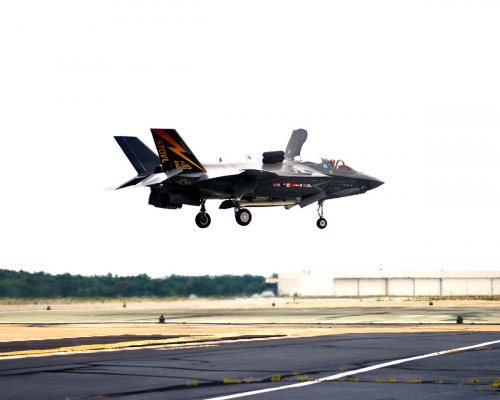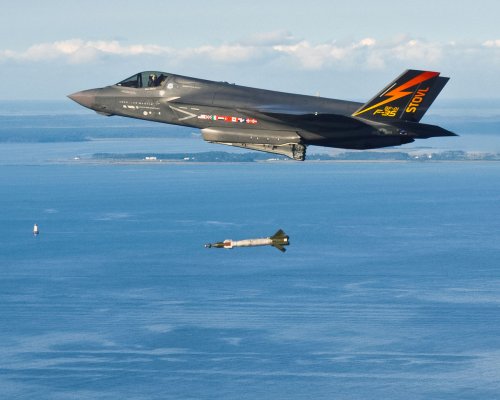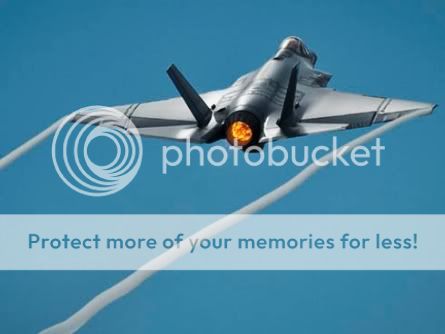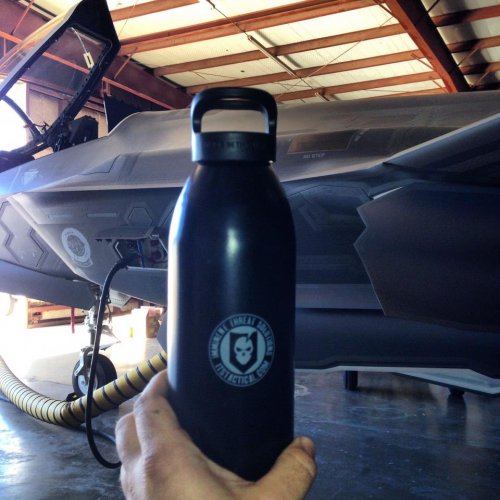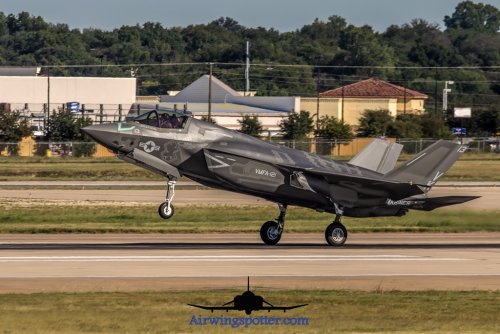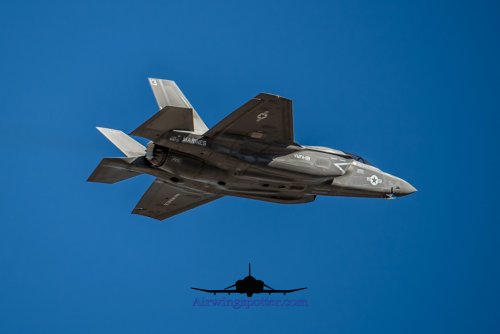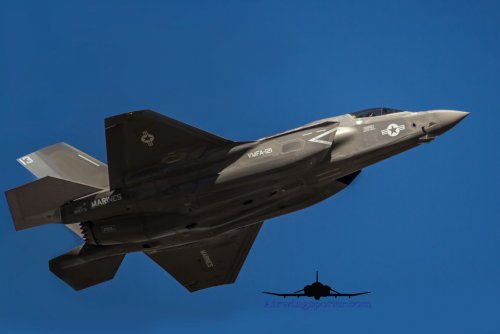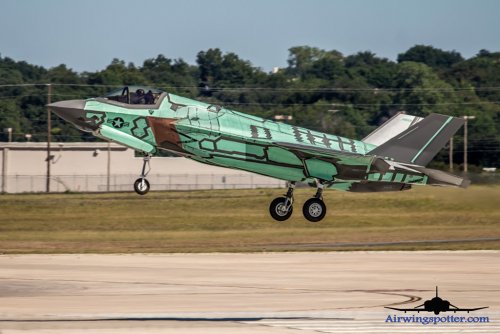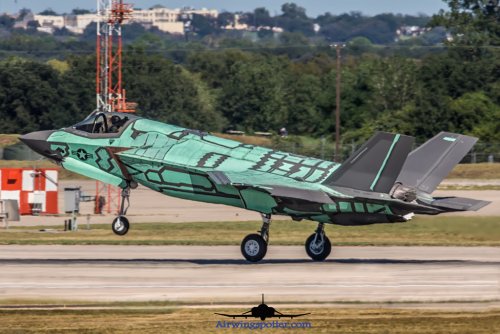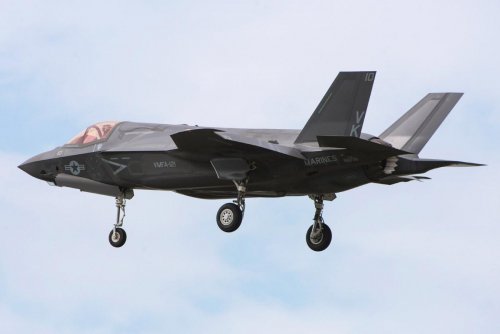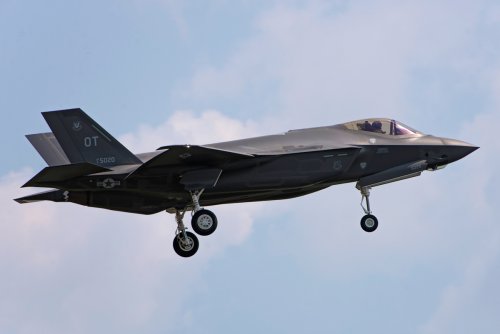F-35: New Fighter Creates New Culture for 21st Century and Beyond
(Source: U.S Air Force; issued September 24, 2013)
EGLIN AIR FORCE BASE, Fla. --- She didn’t have a smudge on her. Not a leak found anywhere. She even had that “new jet smell.” Skies were blue, everything was perfect. Those were the conditions on that July day in 2011 when Lt. Col. Eric Smith took off from the Lockheed facilities at Fort Worth, Texas, in the first operational F-35 to fly to its permanent home at Eglin Air Force Base, in the Florida panhandle. And the rest, according to Smith, who would go on to pick up three of the first six F-35s from the factory, is history.
“It was just a great day – I was just a little bit nervous because I knew that if I messed it up it would be on the front page of every newspaper in the country,” said Smith. As he approached the runway at Eglin, he found bleachers full of people and a red carpet rolled out to signify the beginning of an era for not only the plane, but for the newly reorganized 33rd Fighter Wing, Eglin Air Force Base and the future of Air Force air superiority for the 21st Century.
The pick of the 33rd Fighter Wing “Nomads” to transition the Air Force’s newest and most lethal fighter into this century and beyond was no accident. With a history that dates back to World War II when the wing was a pursuit group, the 33rd showcased the F-4 Phantom during Vietnam and the F-15 Eagle through crises such as Grenada, Panama, Desert Storm, and post 9/11, when the Nomads provided armed over-watch throughout North America for Operation Noble Eagle, securing two presidents of the United States and multiple space shuttle launches.
“On Oct. 1, 2009, we stood up as an F-35 unit,” said Lt. Col. Matt Renbarger, 58th Fighter Squadron commander. “We were handed keys to an empty building, with five pilots, a technical sergeant, two lieutenant colonels and three majors.”
Renbarger and Smith both admitted that those early days, following the arrival of the first F-35, was a whirlwind of planning, creating policy and guidelines and putting together a training program with a syllabus, academics, and a completely new maintenance program.
Smith said that the early days with the first few aircraft were a challenge, not only for the pilots, but for the newly trained crew chiefs as well. “There was a lot of tech data that the technicians needed before they could work on the airplane, so the first six planes we delivered sat for about eight months before we were issued flight clearance. We didn’t receive our first flight clearance until March of 2012. “
Renbarger said that, like anything brand new and right out of the box, there were a lot of things that had to be learned that weren’t known before. He said that as a training unit, it was more Air Combat Command versus Air Education and Training Command. “It’s not a different mindset, but it’s more of a different mission. Here we create new pilots and maintainers, so we don’t have the downrange focus. Training pilots is our product.
“When test pilots at Edwards find something they tell us, and when we find something we tell them. When software is released they’ll come down here and tell us things they’ve learned. We’ll take new capabilities and bring them into our training syllabus. The folks at Edwards bring us the latest so we can teach the people who teach the people. We teach the teachers and the teachers teach the students.”
Renbarger said there is a lot to like about the F-35, from the standpoint of the pilot, the maintainer, the trainer, down to the bottom line of mission success. “I’ve never seen a pilot come back from his first sortie without a huge smile on his face. It’s something new, and programs like this only come around every 30 years or so, and to be on the ground floor – it’s the perfect time.
“Most pilots come from the F-16, F-15 and A-10 legacy aircraft. Sensors on the front of the F-35 allow us to have that 360-degree awareness. That was the big leap forward. Computer technology that is 30 years or more advanced than the legacy aircraft is what makes the F-35 so advanced.”
Lt. Col. Anthony Pelkington is the 33rd FW chief of safety and was one of the first of the legacy pilots selected for the F-35 program. He said that for pilots transitioning from those legacy systems, the F-35 is a huge deal.
“For 10 years in the F-16, I dealt with essentially monochrome cathode ray displays – approximately 6 inch square – and I’ve got two of them. Now I move up to a contiguous 8 x 20- inch color display that is a huge step forward for the pilot’s situational awareness. Plus, there’s a lot more capability in the display itself.
“In the F-16, I had a radar display with a selectable, like turning pages in a book, something that would show my ordnances like I had a stick figure map with monochrome lines on a black background. It would try to give us a semblance of where we were to maybe a weapons system. But I had to choose. Every one of those displays was limited to the confines of that small 6-inch to 8-inch screen.
“In the F-35, we now have this massive amount of screen real estate. I can now see multiple sensors at once, which is great because I don’t have to pick and choose. I don’t have to take away my situational awareness with what the radar is telling me in terms of traffic to bring up situational awareness and what the target pod looks like. It’s all there available for me.”
Pelkington added that one of the best aspects of the fifth generation fighter is its ability to communicate with all aspects of the aircraft, as well as customize information to fit each pilot’s needs. “The displays talk to each other, the sensors talk to each other, and a lot of information is displayed in sensible formats with other sensors in one combined picture. Now I can bring up large formats on displays so I can see things easier – I can even bring up many formats if I want with a different orientation on how the displays will look. Whatever I want to do to aid my situational awareness I can do and the reality, as a pilot, is that I can customize that setup quite easily to a format that best suits how a pilot understands.”
The wing’s safety chief said that one of the biggest advantages to the F-35 over legacy aircraft is the growth in options. “Choosing between a pilot’s eye and ‘god’s eye are all in the system now and weren’t in the F-16. I had one particular display option for radar format for the F-16 – I couldn’t choose anything else. I had to learn to read it in that manner. Which didn’t necessarily match how somebody looking out on a battlefield could see the picture. So you always had to do that conversion in your mind. With the F-35 you can choose the display format that best suits your ability, and there are multiple options to allow you to see things from a ‘god’s eye’ perspective. It allows me to see from a much greater perspective than the F-16 ever allowed.”
The equipment
Tech. Sgt. Andre Baskin is the wing’s aircrew flight equipment NCOIC, responsible for equipping pilots with the specialized gear required to fly the world’s most state-of-the-art aircraft. He and his small staff of specialists agree that the differences between the F-35 helmet and the rest are many.
“One of the biggest differences the F-35 helmet has over the others is that the new helmet encompasses multiple gadgets such as night vision goggles, and for that function you would have to modify the pilot’s flying helmet and add the components on there,” said Baskin. “With the F-35, it’s all encompassed in the helmet. The cameras on the jet work in sync with the helmet and whatever the jet picks up visually will be displayed on the visor in the helmet.”
From a pilot’s point of view, Renbarger agrees that the nicest part of the new helmet is that everything is self-contained. “The best thing about the F-35 helmet is that it has a big visor with a big display, and we can display a night vision camera visual on the visor and then a distributor aperture system that is basically a set of cameras that are all over the airplane and work in the infrared spectrum. That can be displayed on our visor as well.
“When we get our helmet fit, there is actually a complicated scan process that takes an image of our heads and provides a laser cut-out foam insert for the helmet that is molded to our heads. Then there’s ear cups that close the helmet around our head and a custom nape strap in the back that basically locks the helmet down on our heads. There’s very little, if any, motion in the helmet when we move our head around. Very well balanced, a very well fit and it feels great wearing the helmet. It’s very specific to each individual pilot.”
Pelkington also talked about the difference between the traditional G-suit, which offers pilots about a G and a half of protection, to the one used by F-35 pilots. “Some pilots acclimate to the Gs by genetic makeup, some by experience and can develop a tolerance for 5-ish Gs. With the new suit you can now go up to 7 or 8 Gs without ever having to strain. When you’re focused on pulling Gs -- on making sure your eyesight doesn’t gray out – your mind isn’t thinking about the adversary or the situation or the awareness of the battlespace. When you can pull 7 or 8 Gs without having to think about it, combined with the fusion of all the systems and the display on the glass set up the way you want to see it…it’s an amazing reduction in pilot workload.”
The maintainers
Senior Master Sgt. Paul Fulkerson is the production superintendent with the 58th Aircraft Maintenance Unit who is on the ground floor of maintenance for the F-35. He said that for F-35 maintainers, the biggest element that sets them apart is the electronic maintenance program called ALIS. Standing for Autonomic Logistics Information System, ALIS, according to Fulkerson, has all of the forms needed to perform maintenance on the new aircraft.
“With ALIS, there are no paper forms and the system allows maintainers to pretty much manage the fleet with the information on the computer,” said Fulkerson. “With the F-16s, we had to use paper tech data to perform maintenance, where you followed it step-by-step to do the task. With ALIS, our maintainers us ‘tough books,’ where they read the tech data on the screen.”
While a very young aircraft, Pelkington said the F-35, maintenance-wise, is very stable and makes a lot of information available to both the pilot and maintainer that isn’t available on the legacy aircraft.
“Oftentimes, in a legacy aircraft, you don’t know that something is wrong until you have a major systems failure that generates a warning in the aircraft. The aircraft can no longer perform to spec. A lot of warnings in the F-35 tend to be advisory, that says ‘this is going to have to be worked on by maintenance when you land.’ In the F-35, there’s no mission degradation. When a pilot gets back, there’s a load of data on every aspect of how the aircraft performs. From the maintenance standpoint, it gives them an awesome opportunity to catch issues before they become problems.”
Staff Sgt. Michael Sanders is an F-35 crew chief who has been with the program for the past three years and has more than a decade of experience on the F-16 and F-15 as a backshop engine maintainer. He explained that while maintainers in the legacy aircraft normally specialized in one area, such as engines or avionics, in the F-35, maintainers do it all.
“My job is completely different now from in the past. We would handle all teardown and build-up required for the engine, whereas now, we perform maintenance on the F-35 as a whole. We’re trained on all maintenance tasks, including the engine. I traveled TDY to Connecticut where I performed teardown and buildup for the new aircraft.”
Training
The F-35 Academic Training Center, or ATC, is a sprawling complex responsible for every facet of F-35 training at Eglin. From pilots to maintainers to support Airmen, the ATC has developed, or is in the process of developing, the training syllabuses, procedures, guidelines, certifications and “textbooks” that will become the training standard for decades to come, according to Renbarger.
He said that for pilots, training in the F-35 simulator is by far, the best there is. “I’ve flown in F-16 simulators and F-22 simulators and the F-35 simulator is truly state-of-the-art. They’ve got the best visuals, full dome coverage, 360-degree views, target set build-up, they have runways and very much replicates flying the airplane. I haven’t heard one pilot say it wasn’t the best simulator they’ve ever been in short of flying the airplane.”
Renbarger added that because the F-35 is a single-seat plane, the first time a pilot flies the F-35, he’s by himself, making the simulator even more critical. “The operational flight software that runs the airplane – that same software is in the simulator,” said Renbarger. “In other aircraft I have flown, there have been differences between the simulator and the airplane. This is as close as I’ve ever seen between the simulator and airplane. Exact same cockpit. The cockpit sits on a rail and you sit in the cockpit and it drives forward and raises up inside the dome and the screens you see are the exact same screens you see on the jet.”
On the maintenance side, students are confronted with a similar real-world view, with a weapons load trainer mock-up of the F-35 that contains everything but the tail and the cockpit. Tech. Sgt. Adam Zakrzewski is an ATC instructor with Detachment 19 of the 372nd Training Squadron. He said that during training on the F-35, students will practice opening and closing doors, checking the hydraulics levels, oil levels, etc., but there’s a big difference between maintenance on legacy aircraft versus the F-35.
“There are a lot more steps in gaining access to the legacy aircraft than there are to accessing the F-35,” said Zakrzewski. “I’m an old A-10 guy, where you have to unfasten 200 screws to get a door panel open. On the F-35, there’s one interface connect and click two buttons.”
Tech. Sgt. Justin Weddle is an ATC instructor and flight chief with the field training detachment of the 372nd Training Squadron, who says that in normal maintenance training, instructors would give students a PowerPoint presentation, cover some TOs and give students hands-on training on the aircraft.
“The maintenance group would have to give up an aircraft or whatever students were training on such as a weapons system, AGE, anything like that. At the ATC, and in the F-35 training plan, we begin with an EML, or electronic mediated lecture, kind of like the traditional PowerPoint, but it’s done through an electronic system.” Weddle said the student will then transition, in the same classroom and setting, to more self-paced training on the computer. “It’s just a reinforcement of what the instructor has said during his portion of the training.
“Students will then go through an ASMT, which is an aircraft systems maintenance trainer. It’s essentially an avatar, and from that you go and do whatever task you’re learning about. Whether you are installing a hydraulic pump or some other portion of the aircraft. On one side of the screen, students will have their avatar and on the other they’ll have their joint tech data laptop and they can follow all of the steps exactly. That way the training is not all front-loaded, it can be weaved in and out of the training course.”
F-35: Fighter of the future
In addition to the Air Force’s F-35A, the Marine Corps and the Navy have their own versions of the F-35. The F-35B will give the Marine Corps a short take-off and vertical landing capability, while the Navy’s F-35C will give them a carrier-based capability. Smith believes that for the future of the F-35, it may not change the way we fly, but it will make the U.S. and its allies the dominant air power for the next 30 to 50 years.
“That’s the beauty of the F-35. There are three variants out there, but all three are going to use the same system software. So as they develop something new for our country, our allies who fly the F-35 will get that same capability. That will make integration much smoother.”
Since Smith’s journey home with the first F-35 in 2011, Air Force, Marine, Navy and U.K. pilots have amassed more than 3,100 flying hours in the three versions, flying more than 2,300 sorties.
To those who have spent the past the past four or five years learning the intricacies of a new aircraft -- how to fly it, how to fix it and how to create a plan to teach it, the F-35 has become much more than an airplane showcasing state-of-the-art technology. For the men and women of the 33rd Fighter Wing at Eglin, responsible for getting the F-35 ready for its grand entrance as the dominant airpower for the 21st Century and beyond, it has spawned a completely new culture and way of life.
-ends-

